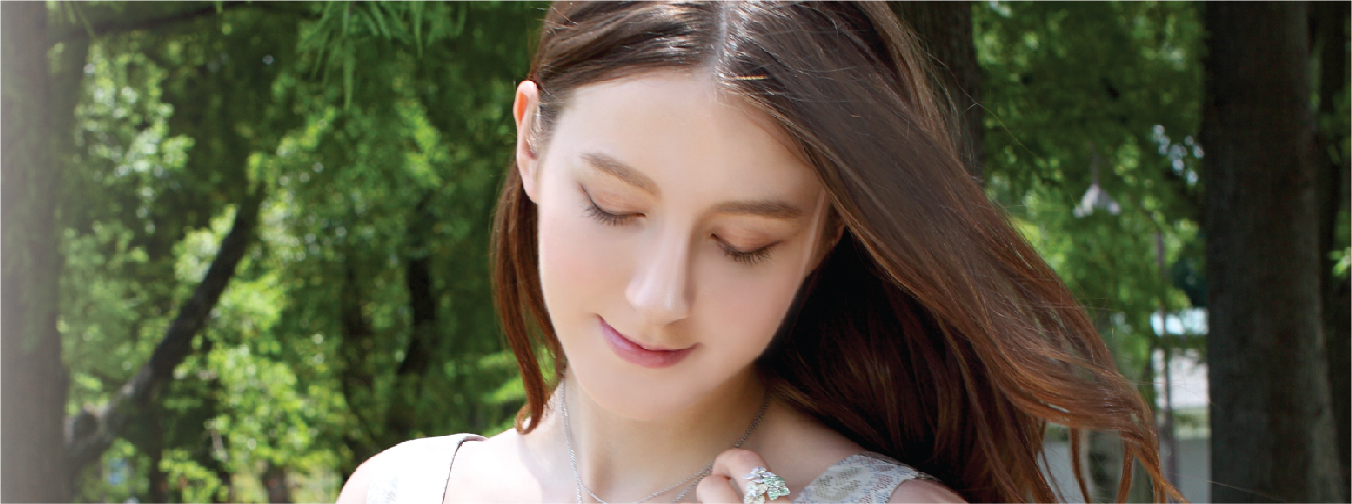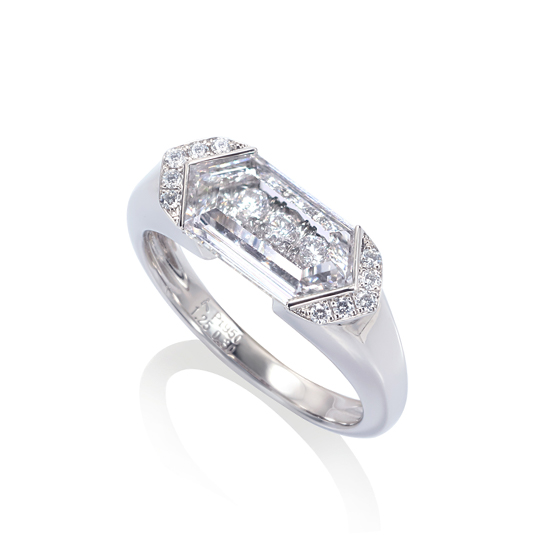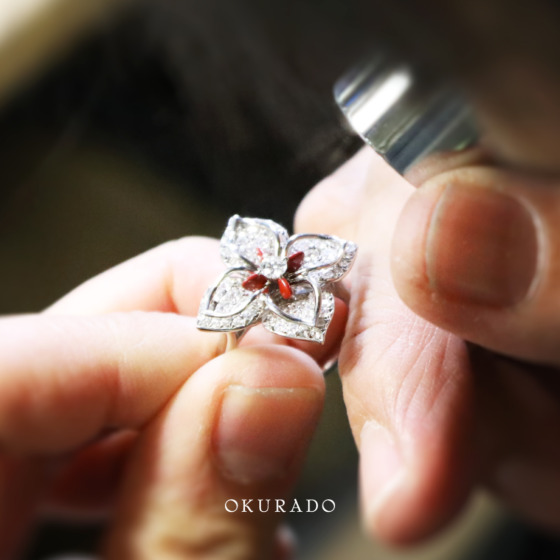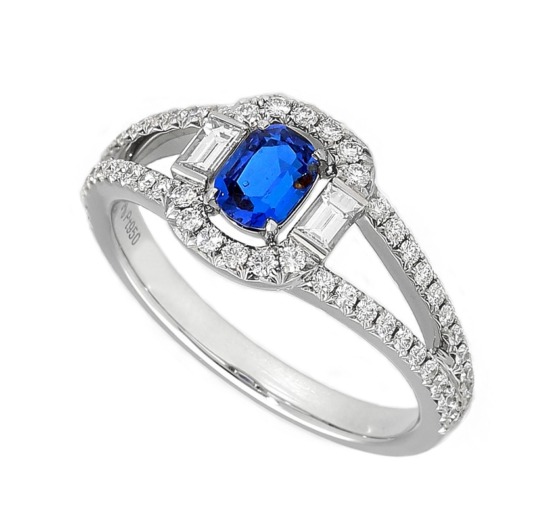今回はジュエリーの貴金属部分を磨くお話をします。
大倉堂で使う貴金属の種類は主にゴールドは18K(75%が金、残りの25%は多くの場合銀と銅)、プラチナはPT950(プラチナが95%、残りの5%はプラチナ族の金属)です。
この金属部分を磨いて光沢仕上げをする作業は、実はとっても手間がかかる重要な作業です。
基本的に表面に凸凹があると金属は光りません。(鋳造したての金属は細かい凸凹があり、まったく光っていません)。
表面を可能な限り凹凸を無くし、平にしていくことにより金属は光り始めます。
例えば鏡が自分の姿を写すのは鏡の表面が平らだからです。 金属もこのように磨いていけば鏡のように自分の顔を見ることができます。
ジュエリーではいろんな道具を使って金属の凸凹をなくすように磨き輝きを出していきます。
磨きの方法は、高速で回転する研磨機、先端の細い道具が回転するリューターや、磨く道具が入らない部分は糸で磨くこともあります。
実はジュエリー製作の工程で、この磨きの作業だけで数日を要する事も稀ではありません。
そのうえジュエリーは複雑な形であったり、曲面をもっていたり、細かい溝もあったりとデザインによって形状はいろいろです。
大倉堂では磨きのフィニッシングを20倍の顕微鏡を使って行います。
20倍の顕微鏡をお宅でお持ちの方は少ないと思いますが、ルーペや虫眼鏡で一度見ていただくとそこには全くの別世界が広がります。
なぜそこまでの顕微鏡を使ってとお思いになるでしょう。
それはこういう理由からです。
使用するダイヤモンドやカラーストーンなどの宝石はもちろん宝石自体で綺麗に輝きますが、金属の光沢の反射によってその輝きがより増すのです。
宝石の周りの金属がきれいに磨かれていれば磨かれているほど宝石は輝きを増します。
もう一つ。 人間の目は不思議なもので、肉眼で見えるキズや凹凸は限界があるのですが、本当に鏡のように綺麗に磨かれたものから醸し出される高級感のある「品格」を感じることができるのです。
私はこの「品格」はジュエリーにはとっても大事な要素と思っています。
まさに「美は細部に宿る」です。

もしお時間があれば一度お持ちのジュエリーの細部を虫眼鏡やルーペで御覧になってみて下さい。 丁寧に作られたジュエリーの細部にはちゃんと職人の磨きの手が入っているはずです。
大倉堂工房の職人は手掛けているジュエリーを、朝から晩まで何日もの時間をかけてただひたすら磨き続けています。 非科学的な言い方になりますが、それだけ長い間ひとつものと向き合って磨いていれば、職人の想いがジュエリーに入っても不思議じゃないな、とさえ思います。
できあがった商品は検品をするスタッフの手に渡るのですが、20倍の世界で磨きあげられた品物とともに職人から「素手で触ると傷つくので、いっさい触らずお客様に届けて欲しいです。」と言われるのもけっして珍しい話ではないのです。
大倉堂 OKURADO
大倉仁
Polish
In this issue, we will talk about polishing the precious metal parts of jewelry.
The precious metals used at Okurado are mainly 18k gold (75% gold, the remaining 25% is often silver and copper) and PT950 platinum (95% platinum, the remaining 5% is metals of the platinum group).
Polishing these metal parts to a shiny finish is actually a very labor-intensive and important process.
Basically, if the surface is uneven, the metal will not shine. (Freshly cast metal has fine irregularities and does not shine at all).
) By making the surface as even and flat as possible, the metal begins to shine.
For example, a mirror reflects your image because its surface is flat. If metals are polished in this way, you can see your own face just like a mirror.
In jewelry, various tools are used to polish metal to eliminate irregularities and bring out its brilliance.
Polishing methods include polishing machines that rotate at high speed, leutors that rotate with a fine-tipped tool, and sometimes using thread to polish areas where polishing tools cannot fit.
In fact, it is not uncommon for this polishing process alone to take several days in the jewelry making process.
In addition, jewelry can have complex shapes, curved surfaces, and fine grooves, depending on the design. Okurado uses a 20x microscope for the finishing process.
Few people have a 20x microscope at home, but once you see it with a loupe or magnifying glass, a whole new world opens up to you.
Why, you may ask, would anyone want to use such a microscope?
Here’s why.
Gemstones, such as diamonds and colored gemstones, shine beautifully on their own, of course, but their brilliance is enhanced by the reflection of the luster of the metal.
The more polished the metal around the gemstone is, the more brilliant the gemstone will be.
One more thing. The human eye is a strange thing, and while there is a limit to how many flaws and irregularities we can see with the naked eye, we can sense the luxurious “dignity” exuded by something that is truly polished as clean as a mirror.
I believe this “dignity” is a very important element in jewelry.
It is exactly like “beauty is in the details”.
If you have time, take a look at the details of your jewelry with a magnifying glass or loupe. The details of a carefully crafted piece of jewelry will have been polished by our artisans.
Okurado Workshop’s craftsmen polish their jewelry from morning to night, for days on end. It may sound unscientific, but if they spend that much time polishing a piece of jewelry, it is no wonder that the jewelry contains the craftsman’s thoughts and feelings.
When the finished products are handed to the staff who inspects them, it is not unusual to hear the craftsman say, “If you touch it with your bare hands, it will get scratched, so please deliver it to the customer without touching it at all. It is not at all unusual for a craftsman to be told, “If you touch it with your bare hands, it will get scratched.
Hitoshi Okura
OKURADO











